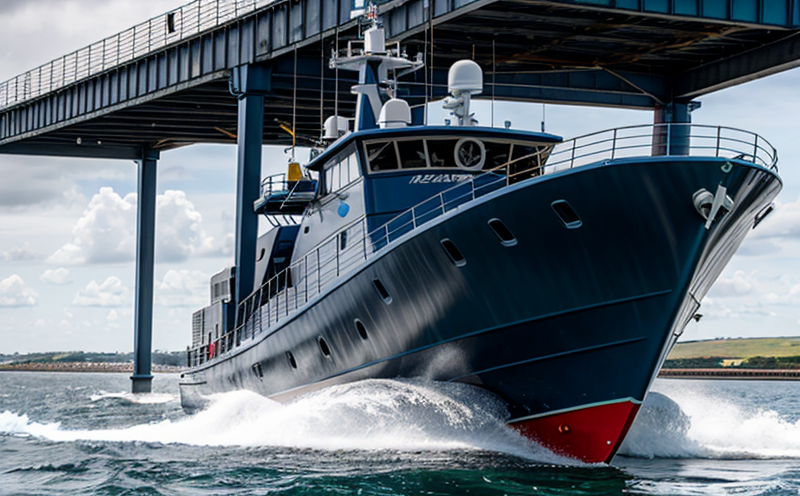ISO 1940 Propeller Shaft Balancing Testing
The ISO 1940 standard defines the permissible unbalance values for rotating parts to ensure optimal performance and longevity of marine propulsion systems. This balancing test is critical in the design and manufacturing stages of propeller shafts, ensuring they operate smoothly under various operating conditions without causing excessive vibration or premature wear.
The process involves measuring the static and dynamic imbalance of a propeller shaft using high-precision equipment. Static imbalance occurs when there are weight differences between two halves of the rotating part, while dynamic imbalance arises from asymmetrical distribution of mass during rotation. Both types can lead to increased fuel consumption, decreased engine efficiency, and potential structural damage over time.
During the test, a propeller shaft is mounted onto a special balancing machine designed to rotate it at controlled speeds. Sensors within the machine detect any imbalance by measuring forces acting on the shaft's axis as it rotates. The data collected provides detailed information about where and how much weight needs adjustment for optimal balance.
After identifying imbalances, adjustments are made using various techniques such as adding or removing weights along specified points on the shaft. These modifications aim to minimize residual unbalance, ensuring smooth rotation during operation. Proper balancing not only enhances performance but also extends service life by reducing stress on bearings and other components.
In addition to improving efficiency and reliability, ISO 1940 compliant propeller shafts contribute significantly to environmental sustainability by minimizing fuel consumption and emissions from marine engines. This aligns with global efforts towards greener technologies in the maritime industry.
Compliance with this standard is essential for manufacturers aiming to meet stringent international regulations governing shipbuilding standards worldwide. It also helps ensure consistency across different models produced by a company, allowing easier maintenance and replacement parts availability.
For quality managers responsible for overseeing product development processes, adhering to ISO 1940 ensures that their products conform to industry best practices. Compliance officers will find this testing crucial in maintaining regulatory compliance throughout the supply chain. R&D engineers benefit from precise balancing results which inform design iterations aimed at further reducing unbalance values.
By focusing on these aspects, companies can enhance overall product quality while meeting customer expectations regarding performance and longevity. Properly balanced propeller shafts contribute to safer operations by preventing issues such as resonance vibrations that could damage critical machinery or cause accidents in severe cases.
Why It Matters
The importance of ISO 1940 compliance extends beyond mere adherence to international standards. It plays a pivotal role in ensuring the safety, efficiency, and longevity of marine propulsion systems. When propeller shafts are properly balanced according to this standard, they operate more smoothly under various loading conditions, which reduces wear on bearings, seals, and other components.
Proper balancing helps prevent premature failures due to excessive vibrations that can cause structural damage over time. This leads to increased operational reliability, lower maintenance costs, extended service intervals, and reduced downtime for vessels. From an environmental perspective, balanced propellers contribute to better fuel efficiency, thereby reducing greenhouse gas emissions from ships.
For stakeholders involved in the design, manufacturing, and operation of marine equipment, understanding why ISO 1940 matters is crucial. Quality managers must ensure that every aspect of production adheres strictly to these standards; compliance officers need to verify that suppliers meet required specifications; R&D teams should incorporate balancing considerations into new designs.
The significance of this test cannot be overstated when considering its impact on operational efficiency and safety in the maritime sector. By prioritizing ISO 1940 compliant processes, organizations demonstrate their commitment to excellence while maintaining competitive advantage through superior product quality.
Why Choose This Test
Selecting ISO 1940 propeller shaft balancing as your preferred testing method offers numerous advantages that set it apart from other available options. Firstly, this standard provides a robust framework for evaluating the balance quality of rotating parts, ensuring consistency across different manufacturers and models.
Secondly, compliance with ISO 1940 demonstrates commitment to high-quality manufacturing practices, which is increasingly valued by customers seeking reliable products that meet stringent performance criteria. Thirdly, adhering to this standard helps avoid potential risks associated with unbalanced components, such as increased maintenance costs and shortened service lives.
Additionally, choosing ISO 1940 ensures compatibility with international regulatory requirements governing shipbuilding standards worldwide. This makes it easier for companies to export their products without facing additional challenges related to different national regulations.
Finally, selecting this test offers peace of mind knowing that you are investing in a process proven through rigorous testing procedures recognized globally within the industry. By opting for ISO 1940 compliant balancing services, you can rest assured that your propeller shafts will perform consistently and reliably under all expected operating conditions.
Customer Impact and Satisfaction
The impact of ISO 1940 compliance on customer satisfaction is profound. When manufacturers follow this standard, they produce propeller shafts that meet stringent performance criteria, leading to enhanced product quality and reliability.
Customers benefit from reduced maintenance costs and extended service intervals as balanced components last longer without requiring frequent repairs or replacements. This translates into significant savings over the lifecycle of a vessel, making it an attractive feature for both new builds and retrofits.
In terms of operational efficiency, balanced propeller shafts contribute to better fuel economy by minimizing unnecessary energy losses due to vibration. Lower fuel consumption reduces operating costs while also contributing positively to environmental sustainability goals.
The reputation of a company that adheres strictly to ISO 1940 standards enhances its market position among discerning buyers who prioritize quality and reliability in their procurement decisions. This positive image fosters long-term relationships with satisfied customers, fostering loyalty and repeat business opportunities.
Ultimately, choosing ISO 1940 propeller shaft balancing not only improves the performance of individual components but also contributes to overall vessel efficiency and safety. By investing in this service, manufacturers ensure they are delivering products that meet global standards while satisfying customer expectations for superior quality and reliability.





